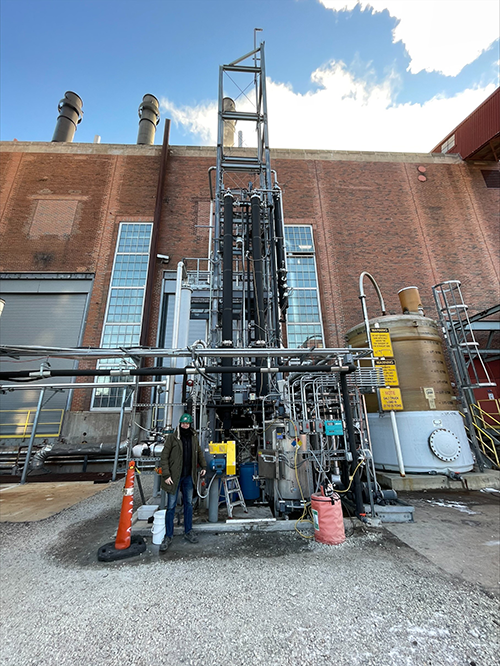Biphasic CO2 Absorption Process (BiCAP)
To help the U.S. meet its new carbon capture goals, ISTC is working in collaboration with the Illinois State Geological Survey (ISGS) and the Applied Research Institute on the campus of the University of Illinois at Urbana-Champaign and external partner Trimeric Corporation of Buda, Texas, to develop an innovative, low-cost approach for CO2 capture from burning coal during electrical generation.
Lab-Scale Project
With funding from the U.S. Dept. of Energy in October 2015, ISTC is assisting ISGS to develop a novel biphasic solvent process at a lab-scale (10KWe) for CO2 capture. The objectives of this lab-scale research project are to:
Demonstrate a novel biphasic CO2 absorption process (BiCAP). Generate engineering and scale-up data to leverage the technology to the bench- or small pilot-scale demonstration level.
New Technology vs. Conventional Carbon Capture
The conventional CO2 absorption process (e.g., Monoethanolamine [MEA]; Figure 1) starts with carbon dioxide-rich flue gas entering the absorber where the CO2 is absorbed and mixed with a solvent (in this case MEA); the clean gas leaves the top of the absorber. Then the CO2 rich solvent passes through a heat exchanger and a stripper where the solvent is stripped of the CO2 and returned to the absorber. The concentrated CO2 is then pressurized. While conventional carbon capture methods are effective in removing CO2, they are very energy intensive and nearly double the cost generating energy.
The introduction of a biphasic solvent method after the absorber (Figure 2) helps increase the stripping capacity due to the increased concentration of CO2 in the second solvent phase. In addition, there is less energy and compression work required to compress the CO2. However, the equipment needed is still the same size as the conventional carbon capture technology making this method only slightly less cost intensive.
In Period I of this project, ISGS developed an advanced biphasic CO2 absorption process, dubbed BiCAP (Figure 3), which has multi-liquid-liquid phase separation (LLPS) that allows low CO2 loading throughout absorption (Figure 4), resulting in faster kinetics. In addition, BiCAP solvents have larger solvent capacities both for absorption and stripping which in turn further reduces the heat needed, compression work requirements, and CO2 stripper size. ISTC researchers evaluated the thermal and oxidation stabilities of biphasic solvents to help find the best one for this study.
In Period II of this project, ISTC and ISGS are studying the corrosive properties of solvents on carbon and stainless steel, which are materials used in power plants. Those results will provide important information for future scale-up of this BiCAP process.
Related publications
Bench-Scale Project
In spring 2018, additional U.S. Dept. of Energy funding was received by ISGS and ISTC for a three-year bench-scale (40kWe) project to further evaluate and test their biphasic extraction method of CO2 extraction (BiCAP).
The primary goal of this new project is to leverage the BiCAP process and validate its technical advantages through a fully-integrated bench-scale testing in a relevant flue gas environment. The proposed technology is aimed at achieving a CO2 capture cost of $30/tonne and >95% CO2 purity to meet DOE’s Transformational CO2 Capture goals.
Results tested with the 40kWe bench-scale unit fabricated and installed at Abbott power plant showed that:
- Monoethanolamine (MEA) or biphasic solvent was stable during operation of the bench-scale unit.
- MEA had a lower gas treatment capacity than BiCAP solvent for the same unit.
- Amine vapor emissions from BiCAP1 solvent was less than that from MEA, consistent with previous laboratory measurements.
- Initial tests for BiCAP1 revealed a heat duty of ~2,200-2,800 kJ/kg of CO2 captured vs. optimal 4,000-4,500 kJ/kg for MEA solvent.
- Bench-scale tests are in progress and will verify if BiCAP2 has better performance than BiCAP1 observed in previous lab-scale tests.
Results are exptect in summer 2023.

40kWe unit at Abbott Power Plant on the campus of the University of Illinois at Urbana-Champaign.